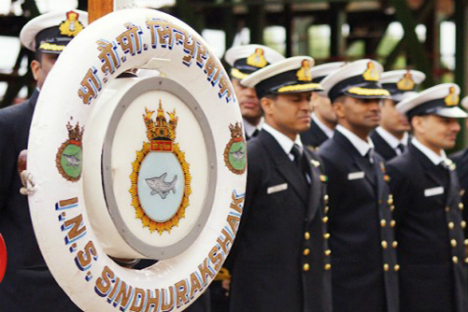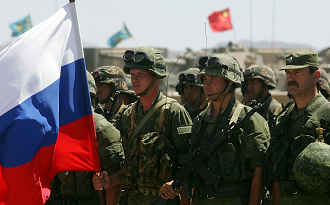Loss of a baby: INS Sindhurakshak's sinking

The tragic accident of the Sindhurakshak has laid bare a major challenge to India's naval capabilities. Source: Oleg Kuleshov
The tragic news of the sinking of INS Sindhurakshak submarine in the wee hours on August 14 at its berth in Mumbai Naval Dockyard was a personal shock for me. It was like hearing the news about the death of a baby, whose delivery I was present for. I distinctly remember the shivering cold and foggy morning of December 24, 1997 in St. Petersburg, where I had arrived at the invitation of the Naval Wing of the Indian Embassy in Moscow to cover the commissioning ceremony of the Kilo class diesel-electric submarine at the local Admiralty Shipyard.
It was a gloomy morning due to overcast sky and small winter daylight hours in St. Petersburg, but Indian and Russian tricolours and insignia of the Indian and Russian navies were brightening the pier of Admiralty Shipyard on the bank of the Neva. The colourful ceremony was graced by Indian Ambassador to Russia Ronen Sen and his wife, Madam Kalpana Sen, Russian Naval Chief Admiral Vladimir Kuroyedov and senior Indian naval officers.
It was for the first time in my life that I had seen the commissioning of a naval warship and everything happening there was very interesting for the 'boy' inside me, who overwhelmed the professional journalist. Lowering of the Russian Navy's St. Andrew's Flag (blue diagonal cross on white background) on the submarines mast with full martial honours and raising of Indian tricolour with Indian seamen lined up on the shore for guard of honour and breaking the coconut on its hull by Mrs Sen with Vedic prayers was so exiting.
Even more memorable was the chat with the officers of INS Sindhurakshak at St. Petersburg's famous Indian restaurant 'Tandoor' (once a favourite joint of Vladimir Putin).
A naval officer of the just appointed crew of the submarine, with an experience of sailing on submarines, said his first desire on returning home from the mission is to get under a shower. The submariners have no arrangement for bathing and have to wear disposable clothes, something like baby pampers. Fresh food is also something they miss after weeks of war patrol in enemy waters. “When we enter home waters and spot our fishing trawler, we surface to get some fresh fish in exchange for steaming rice pulav cooked in our canteen. It is always a welcome exchange at high seas between the fishermen and submariners,” the naval officers said at the reception to celebrate the commissioning of the Sindhurakshak.
Submariners are a different creed of seamen. You need to have nerves of steel and an ice-cold head to serve in the cramped compartments without seeing the sky for weeks in the course of war patrol.
Incidentally, this tragic accident of the Sindhurakshak on the intervening night of August 13-14, almost coincided with the anniversary of sinking of Russian nuclear submarine the Kursk on August 12, 2000 after an explosion of ordnance in its torpedo room.
This tragedy has also laid bare a major challenge to India's naval capabilities. The question is why the long-pending plans for the replacement of the country's ageing submarine fleet are not being implemented. Are India's ageing fleet of conventional submarines threatening to go the MiG-21 way? The Tejas light combat aircraft (LCA), already 30 years in the making, was slated to replace the obsolete MiG-21 in the 1990s. Similarly, the Navy too was to induct 12 new diesel-electric submarines by last year, with another dozen to follow in the 2012-2030 time-frame. But the Navy has not inducted even one of the 24 planned submarines till now.
In the given situation, India needs to seriously reassess its naval requirements as in the unfolding strategic scenario, when there is an urgent need to firmly put in place the naval leg of India's nuclear triad, the Indian Navy would need to project its sustained presence in two oceans – Indian and Pacific to ensure the safety of shipping lines and maintaining a 'credible' nuclear deterrent against China and Pakistan.
Related:

INS Sindhurakshak sunk in Mumbai naval dockyard after explosion
Sindurakshak tragedy: Russian analysts anxious, discuss various causes
Zvyozdochka ready to help investigate Sindhurakshak accident
For this, there is a need to focus on a confident shift to nuclear-powered underwater combat capabilities from conventional submarines. After joining the league of select nations with capabilities to build nuclear-powered submarines, India should also take a cue from great powers, who mostly operate nuclear-powered submarines. Russia, maintains a comparable fleet of Kilo class conventional submarines with India, for combat duties in the Black and Baltic seas. However, nuclear submarines are the mainstay of its underwater combat capability in the oceans.
Collaboration with Russia has laid the foundation of India's nuclear-powered underwater combat capability. Russia's role in the successful implementation of a highly secret Advanced Technology Vehicle (ATV) project for the development of indigenous nuclear submarine is now in the public domain with the commissioning of INS Arihant nuclear submarine. Perhaps, very few people know that Prime Minister Indira Gandhi had initiated the ATV project after the war for the liberation of Bangladesh in 1971. She was highly impressed by the might of a nuclear submarine, when the appearance of a Soviet nuclear submarine in front of the USS Enterprise aircraft carrier in the Bay of Bengal changed the entire war scenario and led to defeat and capitulation of Pakistani army in East Pakistan - now independent Bangladesh.
All rights reserved by Rossiyskaya Gazeta.
Subscribe
to our newsletter!
Get the week's best stories straight to your inbox
